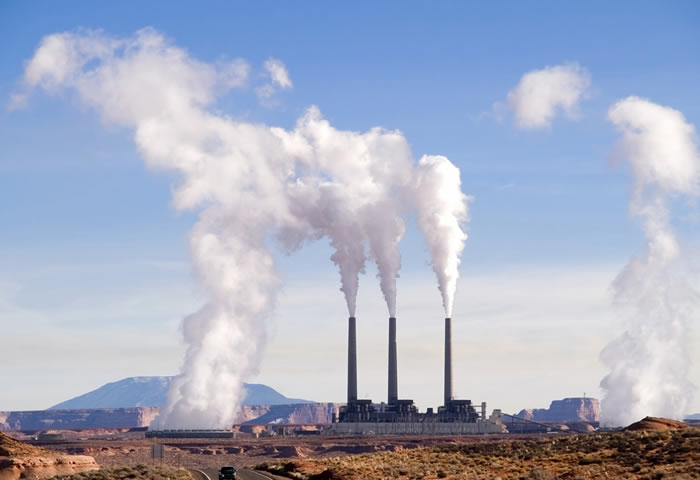Reducing carbon emissions in the atmosphere has been a hot topic for many years, but has become specifically alerting today due to the growing risks of climate change we’re experiencing from fires to floods and rising temperatures.
The rise in global temperatures by trapping solar energy in the atmosphere alters water supplies and weather patterns, changes the growing season for food crops and threatens coastal communities with increasing sea levels. The US Environmental Protection Agency (EPA) forecasts that climate change will shrink water supply thus increasing the demand for water, knowing that the latter is a very important component not only to the human health, but also to manufacturing processes and the production of energy and food. In addition, according to NASA, global warming is likely to cause more wildfires, droughts and tropical storms which are becoming more frequent - the type of 2012's Hurricane Sandy and 2013's Typhoon Haiyan. The storms themselves and the damage to infrastructure they cause often result in a tremendous loss of human life.
Global warming directly indicates weather changing. Unstable temperatures affect the agricultural industry and the human food supply by changing the growing conditions for food corps in many areas. According to the U.S. Global Change Research Program, carbon emissions are causing warming in California's Central Valley that is projected to significantly reduce the yields of tomatoes, wheat, rice, maize and sunflowers in this region. Not to forget that it has an impact on wildlife, forcing animals who hunts for food to migrate to higher altitudes or northern habitats as the climate warms.
Geographical changes are not to be forgotten as well, although they cannot be visually detected rapidly. The change in global temperatures can have dramatic effects on shorelines, especially those densely populated by humans where rising sea levels flood buildings and roads and influence shipping traffic. According to the EPA, sea levels on the mid-Atlantic and Gulf Coasts have risen over 20 centimeters (8 inches) in just 50 years after almost 2,000 years of no observable change.
Yet much of this will get substantially worse with 2.7 degrees Fahrenheit of warming, and far worse at 3.6 degrees Fahrenheit (2 degrees Celsius). According to the Intergovernmental Panel on Climate Change (IPCC), the world is headed for painful problems sooner than expected, as emissions keep rising. The impacts and costs the 1.5 degrees Celsius of global warming registered will be far greater than expected.
The IPCC also reported that 2.7 degrees Fahrenheit could be reached in as little as 11 years—and almost certainly within 20 years without major cuts in carbon dioxide (CO2) emissions. Even if such cuts were to begin immediately it would only delay, not prevent, 2.7 degrees Fahrenheit of global warming.
While a 0.9 degrees Fahrenheit (0.5 degrees Celsius) increase in room temperature is unnoticeable, permanently heating the whole planet that much will have “substantial” consequences, the report warns. The impacts will be felt across ecosystems and human communities and economies.
“Limiting global warming to 1.5°C compared with 2°C would reduce challenging impacts on ecosystems, human health, and well-being,” said Priyardarshi Shukla, Chair of the Global Centre for Environment and Energy at Ahmedabad University in India, in a statement. Such impacts include stronger storms, more erratic weather, dangerous heat waves, rising seas, and largescale disruption to infrastructure and migration patterns.
Under the 2015 Paris Agreement, every country in the world agreed to keep global temperatures well below 3.6 degrees Fahrenheit (2 degrees Celsius) in order to strengthen the global response to the threat of climate change; and as of April 2018, 175 parties had ratified the Agreement, 168 parties had communicated their first nationally determined contributions to the UN framework convention on Climate Change Secretariat, and 10 developing countries had submitted their first iteration of their national adaptation plans for responding to climate change. However, current pledges to cut CO2 emissions will push global warming to at least 5.4 degrees Fahrenheit (3 degrees Celsius) by 2100, risking natural tipping points such as thawing of large areas of permafrost—which could drive global temperatures uncontrollably higher.
The Trump administration, for its part, has pulled the U.S. out of the Paris Agreement, being “an agreement that disadvantages the United States to the exclusive benefit of other countries”, Trump said at a podium in the Rose Garden when announcing the withdrawal.
Global warming is like being in a mine field that gets progressively more dangerous, says Michael Mann, a climatologist and director of the Earth System Science Center at Penn State. “The further we go, the more explosions we are likely to set off: 1.5C is safer than 2C, 2C is safer than 2.5C, 2.5C is safer than 3C, and so on,” said Mann, who was not directly involved in this latest IPCC report.
“Stabilizing global warming at 1.5C will be extremely difficult if not impossible at this point,” Mann said.
The IPCC’s Special Report lays out various pathways to stabilize global warming at 2.7 degrees Fahrenheit (1.5 degrees Celsius). These solutions all require unprecedented efforts to cut fossil-fuel use in half in less than 15 years and eliminate their use almost entirely in 30 years. This means no home, business, or industry heated by gas or oil; no vehicles powered by diesel or gasoline; all coal and gas power plants shuttered; the petrochemical industry converted wholesale to green chemistry; and heavy industry like steel and aluminum production either using carbon-free energy sources or employing technology to capture CO2 emissions and permanently store it.
In addition, depending on how fast emissions are cut, between 0.4 and 2.7 million square miles (1-7 million square kilometers) of land may have to be converted to growing bioenergy crops and up to 3.86 million square miles (10 million square kilometers) of forests added by 2050. And still that won’t be enough, the report warns. Every pound of CO2 emitted in the last hundred years will continue to trap heat in the atmosphere for hundreds of years to come. By 2045 or 2050 there will still be too much CO2 in the atmosphere. More forests or some form of direct capture that takes CO2 out of the atmosphere will be essential to stabilize global temperatures at 2.7 degrees Fahrenheit (1.5 degrees Celsius), the report states.
The challenge to stay below 3.6 degrees Fahrenheit (2 degrees Celsius) is immense, requiring fossil fuel infrastructure to be phased out, non-fossil energy sources phased in, and large-scale removal of carbon from the atmosphere, says Glen Peters, Research Director at Norway’s Center for International Climate Research.
“To stay below 1.5 C simply requires the transformation be faster and deeper than for 2C,” Peters said. Currently, we are going in the wrong direction with global emissions increasing 1.5 percent in 2017 and a likely increase this year, he said. “Without the full involvement and alignment of our technical, social, and political dimensions, 1.5 C and even 2C won’t be possible.”
Not only must humans stop releasing greenhouse gases, but as previously mentioned, they must find a way to take back some of the carbon that has already been released, to limit the rise in global temperature.
This overturn must occur, according to many scientists, in the second half of the twenty-first century. This absorption of CO2 is the blind spot of the fight against climate change. But solutions exist. Three forgotten ideas were put on display at the Global Climate Action Summit in San Francisco to save the climate:
Forests and fields
Trees absorb carbon dioxide through photosynthesis, and help store this carbon in the soil. Deforestation therefore leads to the presence of more carbon in the atmosphere, which warms the planet even more.
For this reason, forests and vegetation in general are seen as a central solution to the carbon problem - potentially hundreds of millions of additional tons of absorbable CO2 per year. If only humans stop clearing.
“It's 30% of the solution, but it receives only 2% of international funding” related to climate change, says Carlos Manuel Rodriguez, the Minister of the Environment of Costa Rica, where the forest area has doubled in 30 years.
Farmland is also important. Field crops naturally absorb CO2 from the air and reinject carbon into the soil. It would be enough to slightly increase the absorbed rate to potentially capture huge quantities: 0.04% or 4 per thousand would do, according to an initiative launched by France in 2015.
For example, Stéphane Le Foll, who runs “4 per 1000”, argues that farmers should plant alfalfa, so that the fields remain covered with plants all year, between corn and wheat season for example. Plus, they should stop plowing, to limit erosion.
“The idea is that when you fly over these lands in 20 to 30 years, there will be no more plots tilled,” he said in San Francisco.
Reduce gas leaks
Hydrofluorocarbon gases (HFC) are refrigerants for air conditioners, but air conditioners are leaking, which warms the atmosphere. By accelerating the replacement of HFCs with other less harmful gases, emissions could drop by 5 to 16% between 2015 and 2025, according to a report released by the America's Pledge coalition.
Leaks from wells and pipelines are another major source of greenhouse gases - in this case methane, which is heating power is much higher than that of CO2. It would be necessary to repair the leaks, to the end of the distribution circuit of city gas pipes.
Suck CO2 from the air
“Sucking” carbon directly from the air is another idea for the moment at the experimental stage. Three companies in Switzerland, Iceland and Canada have developed systems that extract CO2 from the air and store it. For example, CO2 can be injected underground into aquifers, or can be absorbed by rocks.
“It's expensive, it's difficult, but it's conceivable,” says James Mulligan, author of a report on the subject for the NGO World Resources Institute.
The cost is estimated at $100 to $200 per ton of stored CO2, compared to about $50 for reforestation. Significant economies of scale must therefore be completed.
On a personal level, one can also offer a helping hand to help reduce carbon emissions and save money at the same time, by executing simple everyday-tasks. Here are some pointers on how to do it:
Buying products with minimal packaging helps to reduce waste and adding insulation to walls and installing weather stripping or caulking around doors and windows can lower heating costs more than 25 percent, by reducing the amount of energy needed to heat and cool houses. Moreover, a person can turn down the heat while sleeping at night or away during the day, and keep temperatures moderate at all times.
Wherever practical, replacing regular light bulbs with compact florescent light (CFL) bulbs can help enormously. Replacing just one 60-watt incandescent light bulb with a CFL will save you $30 over the life of the bulb. CFLs also last 10 times longer than incandescent bulbs, use two-thirds less energy, and give off 70 percent less heat.
In addition, less driving means fewer emissions. Besides saving gasoline, walking and biking are great forms of exercise.
For what concerns home appliances, they now come in a range of energy-efficient models, and compact florescent bulbs are designed to provide more natural-looking light while using far less energy than standard light bulbs.
Saving electricity and reducing global warming can be done by turning off lights when leaving a room, and using only as much light as needed. It is also important to remember to turn off the television, stereo and computer when not in use.
These steps will take us a long way toward reducing energy use and saving money. Less energy use means less dependence on the fossil fuels that create greenhouse gases and contribute to global warming.









